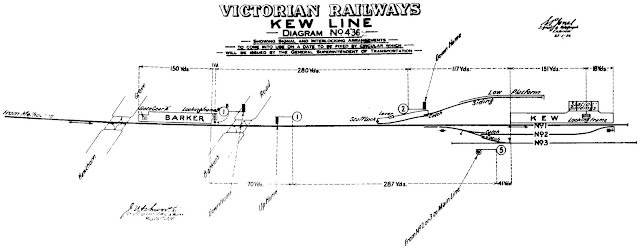Those that know me, know that I have an unhealthy interest in the Melbourne suburban railway network. Melbourne is one of my favourite cities and I find the electrified railway that serves this amazing city fascinating, so much so I'm even building a HO scale model railway layout depicting a suburban terminus station somewhere in greater Melbourne. It was while doing some research online that I stumbled upon an interesting former railway line that has almost been forgotten.
The Kew railway line was a short suburban line that ran from Hawthorne to Kew. The line opened on the 19th of August 1887, the last scheduled passenger train ran on the 18 August 1952 and the line was officially closed on the 13th of May 1957.
Kew has always been an affluent part of Melbourne, and there was a strong want from the local community for a railway line to serve the suburb. The Kew Railway League was formed and pushed for the construction of the line. The league promoted a railway that branched off the Lilydale line from just west of Hawthorne station. The proposed line would then curve away alongside the then Bulleen Road, before passing through vacant land and arriving at Kew.
Bowing to local pressure, the Victorian Railway decided to construct a single track branch line the Kew. A contract for the 2.4 kilometre line was let to the Noonan Brothers at a cost of £18,086.
The route of the new line was criticised by the local council and residents as it was not built on the most direct route to Kew. Victorian Railways planners could feel a bit hard done by as the route was almost identical to the line originally proposed by the Kew Railway League.
Construction was relatively straight forward and the new line officially opened with little fanfare on the 19th of December 1887. The first train left Princes Bridge station (Princes Bridge Station was originally isolated from Flinders Street Station which is on the opposite side of Swanston Street) at 5:40 am, and arrived at Kew to be greeted by the Kew Station Master, a ticket seller and the signalman.
The line departed the western side of Hawthorne station and ran parallel to the Lilydale line for several hundred metres before curving to the north and passing between Lynch Gardens and the Hawthorne Cricket Ground at Glenferrie Oval.
A Victorian Railways drawing of the track layout at Hawthorn railway station. Drawing courtesy of the Victorian Railways.Net website.
The line then entered a curved cutting, where it passed under three road bridges at Chrystobel Crescent, Mary Street, and Kinkora Road.
After passing under Kinkora Road, the cutting ended and the line passed over a level crossing at Hawthorn Grove, before arriving at Barker Station.
Barker Station was the only intermediate station on the line and consisted of the single tracked railway line and a rather substantial brick station building for its status and location.
The Kew and Barker stations were of a standard Victorian Railways design for a suburban station in Melbourne. The stations were substantial brick buildings with good amenities for the station staff.
An image of the platform side of the Kew railway station. Image taken by Frank Stamford and courtesy of the Lost Melbourne Facebook page. www.facebook.com/Lost Melbourne .
To ensure safe working and prevent accidents, the line operated under the train staff safe working system.
When operating the shuttle up and down the line, the guard of the train would collect the train staff for the line from the signaler at Hawthorn, and pass it to the driver who maintained possession of staff throughout the return journey to Kew. On arrival back at Hawthorn on the Up train, the guard was required to sight the train staff before departing back to Kew. After the last Up train, the train staff had to be returned to the Hawthorn signaler. When a goods train worked on the line, the yard porter at Hawthorne was required to get the train staff from the signaler and pass it to the driver. For through trains the Officer in Charge of Hawthorn station was responsible for passing the train staff to the driver of Kew trains.
From its opening, a steam hauled passenger service operated between Hawthorn and Kew at 20 to 25 minute intervals with through trains to the city operating in the morning and afternoon peaks.
On the 24th of November 1930 off peak shuttle services ran between Hawthorn and Kew using a single Tait motor car every 15 minutes on weekdays and every 20 minutes on Sundays. This badly effected patronage as passengers found changing trains at Hawthorn inconvenient. On 29 November 1937 through services were eliminated during afternoon peak with only the single car shuttle services operating on the line.
 A single car Tait electric motor car at Kew Station in 1952. Taken by Lachlan Richardson. Image courtesy of the Victorians Collection website. www.victoriancollections.net.au
A single car Tait electric motor car at Kew Station in 1952. Taken by Lachlan Richardson. Image courtesy of the Victorians Collection website. www.victoriancollections.net.au
Buses began to run off peak services from the 5th of June 1939 due to still falling patronage, with a local shuttle train operating from Hawthorn during peak hours and on Sunday mornings. By October 1939 the Sunday morning trains were also cut.
In 1941, there was only a peak hour train service to and from Kew, with 13 return trips, in the morning and 12 trips in the afternoon and evening. Buses ran the remainder of services at 15 minute intervals. On Monday, the 18th of August 1952 all regular passenger train services were withdrawn. Bus services struggled on for another four years until they too were withdrawn in 1956.



















